
Europe and Mediterranean: Santorini, Rhodes & Mykonos Cruise
Norwegian Cruise Line
Live it up in Europe aboard Norwegian Viva – the newest and most innovative ship. Nestled on the west coast of Tuscany, charming Livorno offers the freshest seafood, awe-inspiring forts, and splendid coastal views with ample cafes and boutiques awaiting your discovery. See Barcelona's diverse architecture during a drive through the city on your way to Montserrat – a picturesque village perched atop rugged mountains where you can visit the Black Virgin statue in the local basilica. Then in Gibraltar, visit the famous Rock of Gibraltar for panoramic views of two continents (Europe and Africa) before descending underground to explore some of the miles of historic tunnels.

Executive Member Benefit
Executive Members receive an annual 2% Reward, up to $1,250, on qualified Costco Travel purchases
Digital Costco Shop Card
Member Exclusive: Digital Costco Shop Card with every Norwegian Cruise Line sailing†
Sailing Itinerary

Note: Cruise itineraries are subject to change. Please verify ports and times directly with the cruise line.
Overview
Today Piraeus is the home base of Greek shipping, the largest commercial fleet in the world, apace bound to the sea like few others. The harbors of Zea and Mikrolimano as well as Phaliro play host to countless yachts and sailing craft throughout the year. Piraeus was known in medieval times as Porto Leone, a name due to the enormous stone lion, which guarded the port's entrance. Today, the life of Piraeus is centered on its three ports: the main, central one, and those of Zea and Mikrolimano. You can walk around the central harbor, shared by cargo and passenger ships alike, and watch the constant comings and goings of goods and people from around the world. Having completed your tour of the central harbor of Piraeus you will then head south traversing the peninsula and arriving at Peiraiki, one of the most picturesque neighborhoods in the city. Here one finds the harbor of Zea, one of the largest marinas in the Mediterranean. If the night finds you in the area, you can try one of the many bars found nearby. You can continue your tour along the waterfront heading towards Kastella but a small deviation toward the city center will be useful for then you can visit the verdant square of the municipal Theatre with cafeterias and shops of all kinds surrounding it. The magnificent building housing the Municipal Theatre as well as the Town Hall and the Library complete the picture presented by the main square in the city. Piraeus's little natural harbors are among its busiest and most touristy areas: Mikrolimano, Passalimani, Zea, Freatida, and Hatzikiriakio. Countless seaside tavernas provide delicious seafood washed down with the uniquely Greek drink, ouzo. The fresh smell of the sea and the sounds made by the assortment of caiques, yachts, and sailing ships, which are moored next to the tables, complete the enjoyment of the food Beyond the port, the most impressive spots are the hills of Profitis Ilias and Kastela with their neoclassical mansions and modern buildings which look as they are hanging over the sea.
Overview
Volos is the capital city of the region of Magnesia. It was built at the foot of the mountain of Pelion and is 325km from Athens, and 216km from Thessalonica. The ancient city "Dimitrias", which is situated a little further out from where Volos is today, was established in the 3rd century BC by the Macedonian king "Dimitrios the Sieger". By the middle of the 6th century AD, it was the centre for shipbuilding. In the town of "Palaia" (Old) the castle of Volos was built. It was here that a market square was created and trading of products began by the people of Pelion and the valley of Thessaly.To protect the market from raiders, a small fortress was built. This was known as the "Kastrin" (Little castle). This fort, through the years, was under the leadership of Byzantine leaders and Ottoman leaders during the Turkish occupation. In 1665 the fortress was attacked, for the last time, by the Venetian navy under the leadership of Morosini. After this attack, they started to build small stores for the products, which were mainly cereals, from the valley of Thessaly. These stores started to spread around the port. Eventually, small houses for the traders started to be built around the east side of the castle.After 1830, a large number of villagers and craftsmen from the villages of Pelion the new state of Greece and other Hellenistic centres started building houses and workshops around the port. This was the beginning of large-scale trading in the area, which was continuously getting bigger and bigger.When Thessaly joined in with the Greek state, a large trading market started, and by the end of the century, there was an explosion in trade and industry. This resulted in the port of Volos becoming the second biggest trade port in Greece after Piraeus. With the port continuously expanding, the rail operation developed to connect Volos with the rest of Greece. This became the fastest and cheapest means of transportation for both products and people and helped Volos become a very rich city. In turn, this increase in wealth also helped with building and development in the area and work started on many neoclassic buildings and churches, such as Agioi Konstantinos, Agios NNikolaosand the church of Metamorphosis. The railway station and many workshops were also constructed during these prosperous times.This development took place at a fast rate and many industries started establishing themselves. Textile, ore and ceramic industries started and led to more wealth and power. The steam train of Pelion "Moutzouris-Smudgy" was built by the Italian engineer Evaristo de Kiriko, and connected the previously unapproachable villages with the port of Volos. Again, this led to an increase in trade and markets.In 1922, after the disaster in Asia Minor, many refugees fled and headed to Volos, where they found new homes and began a new life. They also contributed to trading and developments in the city. A very important landmark in the city's development was the big earthquake in 1955 when almost the whole city was destroyed. The city was rebuilt and is how you see it today. Volos is a very lively city, and its port connects with the North Sporades and has connections with ports all over the world. The rail lines connect it with the rest of Greece and more recently the airport at Anhialos. Today Volos is a big industrial centre and has the third largest port in Greece.Volos consists of the municipalities of Neas Ionias and Iolkos. Volos has a very famous and high-quality open market, which is on level with any other markets throughout cities in Greece.Volos is a very happy and pleasant city. One thing you must do is to visit one of the fish tavernas, "tripouradika", and enjoy fish titbits and tsipouro. Once you have experienced this, you will forever have this picture in your mind and heart.
Overview
Mykonos is world-famous. It is no coincidence that this, the most cosmopolitan of all Greek islands, attracts so many visitors from all over the globe, including large numbers of artists and intellectuals. Here, the steep mountains to be encountered in most of the Cyclades give way to low, rocky hills which combine with superb beaches to make up the landscape of the island. The capital, Hora (Chora), with its colourful harbour in which little fishingboats nestle happily side by side with luxury yachts, presents quite a different picture from the majority of Aegean island towns. While it is usual for island villages to be built on naturally amphitheatrical sites, Mykonos is spread out over a flat area and conveys an impression of lid aesthetic cohesion. Along the whitewashed streets stand brilliant white box-shaped houses with stepped walls for sitting on, wooden doors and windows and brightly-coloured balconies. These are interspersed with small but impressive churches, pretty little tavernas and shops selling souvenirs and other goods, and the overall sense is of being inside a film set. On the low Kastro hill is the complex of churches known collectively as Our Lady 'Paraportiani', a superb arrangement of whitewashed masses created over the centuries and now recognised as a national cultural monument. Of particular historical and aesthetic interest are the medieval houses in this district of the town, which stand like a wall above the sea protecting the west side of Hora. The Archaeological Museum of Hora contains finds from tombs on the nearby island of Rhenia, sculptures, vases and figurines. The Folklore Museum brings together a number of collections of furniture, icons, pieces of sculpture and folk musical instruments. Mykonos is also the home of the Nautical Museum of the Aegean, which has interest all of its own. The countryside of Mykonos is a mixture of grey-green rocks ringed by prickly pear plants and little fertile areas carpeted with wild flowers. Here and there are tiny whitewashed chapels and windmills. Ano Mera is, after Hora, the most important of the older villages on the island. Standing 8 km. to the east of the town, Ano Mera has the interesting monastery of Our Lady Tourliani, ornamented with fine wood-carvings. The church has a collection of valuable ecclesiastical vessels, vestments and embroideries. The courtyard contains an interesting bell-tower and a marble fountain. Here lovers of the sea will find outstanding golden beaches such as Agios Stefanos, Psarou, Kalafatis, Platis Gialos, Ornos, Elia and Panormos. Miykonos is a busy island with all the amenities of a modern resort and with plenty to do - by day or night for those who want to have a lively time. Yet visitors fond of more peaceful holidays will still find quiet corners in which to relax.
Overview
Fira is a comparatively modern town, with houses built mostly during the 19th century when the old Venetian capital at Skaros became untenable due to earthquakes. The architecture is a jumble of Cycladic and Venetian, side by side, the similarities between the two being the stark whiteness. The impact of Aegean tourism has made itself felt in Fira, judging from the abundance of taverns, hotels, discotheques, and shops. It is the largest town on the island and has gained preference with travelers because it is central and access to other parts of Santorini is made easy by either taxi or bus. From there you can indulge in some inspiring coastal walks. Wandering through the white cobbled streets of Fira, a town of about 2,000 inhabitants, one gets the feel of the old-world charm blended in with the modern-day comforts. The town's archaeological museum is crammed with finds from excavations at Akrotiri. But besides being so interesting archaeologically, Santorini is essentially a beauty spot, an island whose cliffs seem to glow under an exceptionally clear light all day, but which at sunset glow redly, evoking that vast explosion more than 3000 years ago.
Overview
The history of Bodrum, known as Halicarnassus or Halicarnassos goes back to the 13th century BC. Excavations reveal the 5000-year-old history of this town. Many civilizations found their home here. Carians for example, Homer tells in his Ilia, that the Carians helped to defend Troya. Herodotus, known as the father of history, was born in Bodrum in 484 BC- and he said that Bodrum had been founded by the Dorians. The next settlers were the Carians and Lelegians. In the 6th. Century BC, the region came under Persian rule. Its most brilliant period was around 353. BC. when it was the capital of the Satrap of Caria (In this century it was famous for its trade, sailing, and boatbuilding.) Artemisia who was a warrior-woman played a significant role in the protection of the Asian Union and she achieved fame by adopting a stance against Rhodes as the Admiral of the Carianfleet in 480 BC. The Mausoleum is Bodrums oldest antiquity and was built by Artemisia II in honor of her husband King Mausolos. It became one of the wonders of the ancient world, Mausoleum still is the general term for a large tomb. The entire structure stood at over 50 meters in height. The first reliefs from the Mausoleum reached the British Museum in London in 1846, these included frescos and other objects.
Overview
The city of Rhodes is situated in the northern part of the island and has a population of 40,000 inhabitants. The town is characterized by modern blocks of flats, wide streets, stores, squares, monuments, picturesque neighborhoods, neo-classical houses, Byzantine churches, and Turkishmosquese. The recent tourist growth contributed to the construction of modern hotel units, nightclubs, tavernas, restaurants, and numerous shops. The sites of Rhodes are varied and interesting. Among them, one should visit the ruins of the Ancient City on the hill of Monte Smith, the mosque of Myrat Reis, the mosque of Souleiman, the Hydrobiological Institute, the churches of Agios Fragiskos, Panagia Nikis, True Cross, Panagia Kastrou, Profitis Ilias and Evangelista, with the beautiful frescoes created by Kondoglou. One should also visit the windmills, the tower of Agios Nikolaos at the port of Mandraki, as well as the green park of Rodini, a few kilometers outside the city. The most impressive part of the city is the Medieval Town, the dominating walls surrounding it, and the Palace of the Grand Magistrates, signifying the city's glorious and glamorous past. One should also visit the museums of Rhodes which are of extreme interest. The Archaeological Museum, housed in the Hospital of the Knights, includes sculptures, pots, and several remarkable findings, while the Folk Museum exhibits a collection of traditional costumes and objects of daily use.
Overview
Iraklion is the capital of Crete and of the prefecture of Iraklion. It is easily accessible from Athens by at least four flights a day. There are international flights from Iraklion to Frankfurt and Amsterdam. Between April and October, there are charters from many other European cities. Iraklion is a very busy city, especially during the tourist season, so it is advisable to book reservations for accommodation before arrival, especially during August. If you are traveling by car there are parking lots near the end of Kalokairinou Street at the Chanioporta and below the Archaeological Museum, one of the many uses of a medieval moat. Make use of them and take the opportunity to see the historical monuments. As you walk up 25 August (Odos 25 Avgoustou) Street you will see numerous agencies advertising tours of all kinds. Santorini, Rhodes, and Mikonos are some of the most visited islands. You can also arrange tours of Knossos, Festos, Gortyn, and the Samaria Gorge. Most of the offices are professional and offer good value. However, to avoid confusion and disappointment, pay attention to the details of the trip, such as the time of pick up, time of arrival at the site, time spent at the site, and entrance fees; these may sometimes be vague. The National Road is easily reached from Iraklion. You can drive to Agios Nikolaos in 1 hr (72km) and Chania in 2 hours (137km). This road is enjoyable and the scenery is spectacular. Drive with caution on all roads in Crete. All means of transportation, including donkeys, farm equipment, and tour buses use the roads at varying speeds. These facts are not truly understood by many of the tourists or even the locals. Iraklion is the fifth largest city in Greece and there has been a settlement here since Neolithic times. Although few remains have been found in the city proper, it was probably a port for Knossos during Minoan and Roman times. The Saracens captured it in 824 A.D. and renamed it El Khandak (The Moat) after the moat they dug around it. The city was regained by the Byzantine Empire in 961 A.D. after many unsuccessful attempts. After the Crusaders occupied Constantinople in 1204, they gave Crete to Boniface of Monferrat who sold the island to Venice for one thousand pieces of silver. Under Venetian rule, the arts flourished, and “Candia”, as the Venetians renamed it, became a center of learning. Many scholars and artists took refuge in Candia after the fall of Constantinople in 1453. The Venetians began construction of the city walls in 1462, which were completed more than a century later. The walls were 4km in length, of a triangular shape, and had seven bastions. The Venetians also built the harbor and various other masterly architectural works. The walls proved their deterrent strength when the city was besieged for 21 years, one of the longest sieges in history. The final surrender came in 1669 after 100,000 Turks and 30,000 Venetians had been killed. Turkish occupation was heavily resented by the Cretans and continuous guerrilla warfare was waged against the Turks and, in return, the Turks often made reprisals against the Cretan population in the cities. Iraklion grew in size after the 1913 union with Greece. However, its strategic location again made it a target for invading forces in 1941. The German bombardment during the Battle of Crete caused a great amount of damage and after the war, the city was extensively rebuilt. Chania was originally the capital of Crete. The administrative center of Crete was transferred to Iraklion in 1971.
Overview
Today Piraeus is the home base of Greek shipping, the largest commercial fleet in the world, apace bound to the sea like few others. The harbors of Zea and Mikrolimano as well as Phaliro play host to countless yachts and sailing craft throughout the year. Piraeus was known in medieval times as Porto Leone, a name due to the enormous stone lion, which guarded the port's entrance. Today, the life of Piraeus is centered on its three ports: the main, central one, and those of Zea and Mikrolimano. You can walk around the central harbor, shared by cargo and passenger ships alike, and watch the constant comings and goings of goods and people from around the world. Having completed your tour of the central harbor of Piraeus you will then head south traversing the peninsula and arriving at Peiraiki, one of the most picturesque neighborhoods in the city. Here one finds the harbor of Zea, one of the largest marinas in the Mediterranean. If the night finds you in the area, you can try one of the many bars found nearby. You can continue your tour along the waterfront heading towards Kastella but a small deviation toward the city center will be useful for then you can visit the verdant square of the municipal Theatre with cafeterias and shops of all kinds surrounding it. The magnificent building housing the Municipal Theatre as well as the Town Hall and the Library complete the picture presented by the main square in the city. Piraeus's little natural harbors are among its busiest and most touristy areas: Mikrolimano, Passalimani, Zea, Freatida, and Hatzikiriakio. Countless seaside tavernas provide delicious seafood washed down with the uniquely Greek drink, ouzo. The fresh smell of the sea and the sounds made by the assortment of caiques, yachts, and sailing ships, which are moored next to the tables, complete the enjoyment of the food Beyond the port, the most impressive spots are the hills of Profitis Ilias and Kastela with their neoclassical mansions and modern buildings which look as they are hanging over the sea.
Onboard the Norwegian Viva
Norwegian Viva
Year Built: 2023
Double Occupancy Capacity: 3215
Introducing the all-new Norwegian Viva, the next stunning ship in a brand-new Prima Class, designed to live life to the fullest. Stay connected to the ocean with extraordinary experiences that bring you closer to the horizon, unwind in the most spacious accommodations to date and experience first-rate service so you can live it up every second.
Activities & Services (included in cruise)

Miniature Golf
- Card Room
- Casino
- Disco/Nightclub
- Game Arcade
- Movies
- Theater/Show Lounge
- Comedy Club
- Fitness Center
- Miniature Golf
- Pool - Children's
- Pool - Outdoor
- Sports Facilities
- Art Gallery
- Bars/Lounges
- Internet Center
- Library
- Children's Indoor Play Area
- Organized Age Specific Activities
- Teen Center or Disco
- Teen Programs
- Business Center
- Concierge Desk
- Elevators
Activities & Services (available for an extra fee)
- Beauty Salon
- Fitness Classes
- Full-Service Spa
- Spa Services/Massage
- Sauna/Steam Room
- Dry Cleaning/ Laundry Service
- Duty-Free Shops/Boutiques
- Infirmary/Medical Center
- Safe Deposit Boxes

Seaside Rotisserie
Specialty Dining
Coco's: Visit the sweetest spot on the ship and indulge in your favorite chocolate temptations, including truffles, ice cream, pralines, and much more. This restaurant is available for an additional cost.
Los Lobos: Bienvenido a Los Lobos, a premium Mexican restaurant celebrating traditional flavors with a modern twist. From Carne Asada marinated in guajillo chiles and tequila to Tres Leches Cake with Coconut Cream, the chefs at Los Lobos focus on unique flavor combinations. (Seating on Ocean Boulevard available.) This restaurant is available for an additional cost.
Nudls: Noodle fans rejoice! From Thai to Italian, Chinese, and more, Nudls brings you the best of noodle dishes from around the world. This restaurant is available for an additional cost.
Onda by Scarpetta: Onda, or "wave" in Italian, brings the charm and effortless elegance of its critically acclaimed sister restaurant, Scarpetta, to sea. Uncork your favorite bottle of wine and let la dolce vita (the good life) flow. Indulge in a modern Italian culinary experience from Scarpetta's signature pasta like the famous Spaghetti Tomato & Basil to unique, mouthwatering seafood creations. And leave room for dessert. Sharing is optional. (Seating on Ocean Boulevard available.) This restaurant is available for an additional cost.
Q Texas Smokehouse: Dig into mouth-watering barbecue short ribs, chicken, brisket, and classic southern breakfast dishes at our Texas smokehouse. This restaurant is available for an additional cost.
Starbucks Kiosk: Whether you're craving a Caramel Macchiato, Teavana® Iced Green Tea Lemonade, or Cappuccino, stop by Starbucks for your favorite morning or afternoon beverage. This restaurant is available for an additional cost.
Seaside Rotisserie: Savor a wide range of rotisserie-style meats cooked to perfection over a spit. This restaurant is available for an additional cost.
Tamara: Spice up your day or evening with a wide variety of classic Indian dishes offered at Tamara. This restaurant is available for an additional cost.
The Garden: Go green at the Garden where we can customize your salad with the freshest ingredients, or you can order one of our delicious premade combinations. This restaurant is available for an additional cost.
Tapas Truck: Before you siesta, enjoy a fiesta of flavors infused into these Latin American tapas. This restaurant is available for an additional cost.
Casual Dining
The Haven Restaurant: Savor an exclusive array of dishes for breakfast, lunch and dinner in a private restaurant serving the finest cuisine. Enjoy stunning vistas indoors or al fresco (exclusively for guests of The Haven.)
The Local Bar & Grill: Located on Ocean Boulevard by Infinity Beach, The Local will warmly welcome you with its beach club atmosphere and live music. So come toast the good life with your favorite frozen cocktails while enjoying incredible views and a variety of culinary delights. (Seating on Ocean Boulevard available.)
Room Service: Available 24-hours a day, simply pick up the phone and order breakfast, lunch, dinner, or late-night munchies. A room service fee of $9.95 will be added to your check (except continental breakfast until 10 a.m. and Suite guests at all times). A 20% gratuity and beverage service charge will be added to your check.
Disclaimer regarding ship dining
This stateroom offers two lower beds that convert to a queen-size bed and two pullman beds.
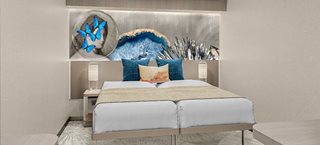
Category: I4
Accommodates 4, total approximate size 160 sq. ft
An affordable family option, these staterooms offer many of the same amenities as an Oceanview and include two lower beds that convert to a queen and two Pullman beds.

Category: IA
Accommodates 2, total approximate size 160 - 254 sq. ft
These Inside Staterooms are the most affordable way to cruise. They include two lower beds that convert to a queen, perfect for two guests to rest and recharge.

Category: IB
Accommodates 2, total approximate size 160 - 254 sq. ft
These Inside Staterooms are the most affordable way to cruise. They include two lower beds that convert to a queen, perfect for two guests to rest and recharge.

Category: IF
Accommodates 2, total approximate size 160 - 254 sq. ft
These Inside Staterooms are the most affordable way to cruise. They include two lower beds that convert to a queen, perfect for two guests to rest and recharge.

Category: IX
Accommodates 2, total approximate size 160 sq. ft
A Sailaway Inside stateroom guarantees an Inside stateroom or better! Your stateroom may be on any deck and assigned between time of booking up to one day prior to embarkation.

Category: IT
Accommodates 1, total approximate size 160 - 251 sq. ft
These staterooms include a queen-size bed and the same amenities as other inside staterooms. Staterooms are priced exclusively for solo travelers and include access to the private Studio Lounge.
These staterooms offer clear views of the ocean, two single beds that convert to a queen-size bed, and a private bathroom.

Category: O4
Accommodates 4, total approximate size 235 - 370 sq. ft
Perfect for families, these staterooms include two lower beds that convert to a queen, a double sofa bed to accommodate two more and a window offering beautiful views. Some also can connect to other staterooms for even more options.

Category: OA
Accommodates 2, total approximate size 235 sq. ft
These spacious staterooms are perfect for two guests to stretch out and relax, featuring a window with beautiful views and two lower beds that convert to a queen. Some can connect to other staterooms, too.

Category: OB
Accommodates 2, total approximate size 186 sq. ft
Enjoy the great views from your window and two lower beds that convert to a queen. Some of these comfortable staterooms can connect, so you can stay close yet spread out. Sleeps up to two.

Category: OX
Accommodates 2, total approximate size 186 sq. ft
A Sail Away Oceanview stateroom guarantees an Oceanview stateroom or better! Your stateroom may be on any deck and assigned up to one day prior to embarkation.

Category: OT
Accommodates 1, total approximate size 186 sq. ft
These staterooms feature a large round window and a queen-size bed. Staterooms are priced exclusively for solo travelers and include access to the private Studio Lounge.
These staterooms include two lower beds that convert to a queen-size bed and additional bedding for up to 2 guests.
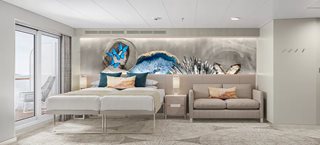
Category: B1
Accommodates 4, total approximate size 268 sq. ft, balcony size 102 sq. ft
These stylish Balcony staterooms are ideal for up to four guests. They include two lower beds that convert to a queen, some with a double sofa bed, spacious bathroom and are located aft, so the view from your private balcony is stunning. Some can connect to other staterooms, perfect when traveling with family or friends.

Category: B4
Accommodates 4, total approximate size 231 sq. ft, balcony size 45 sq. ft
These Balcony staterooms are perfect for the whole family. With room for up to four guests, they include two lower beds that convert to a queen, a double sofa bed, spacious bathroom, plus a balcony to admire the sparkling waters and beautiful vistas together. Some can connect to other staterooms so you can spread out yet stay close.
Note: Cabins 10300, 10900, 11300, and 11900 have a partially obstructed view.

Category: BA
Accommodates 2, total approximate size 231 - 358 sq. ft, balcony size 45 - 69 sq. ft
Balcony staterooms include two lower beds that convert to a queen, a sitting area, and floor-to-ceiling glass doors that open onto a private balcony offering amazing views. Some can connect to other staterooms, perfect when traveling with family or friends.
Note: Cabins 9218, 9818, 10816, 12212, 12812, 13810, 15798, 16192, and 16792 have a partially obstructed view.

Category: BB
Accommodates 2, total approximate size 231 - 358 sq. ft, balcony size 45 - 69 sq. ft
Balcony staterooms include two lower beds that convert to a queen, a sitting area, and floor-to-ceiling glass doors that open onto a private balcony offering amazing views. Some can connect to other staterooms, perfect when traveling with family or friends.
Note: Cabins 9218, 9818, 10816, 12212, 12812, 13810, 15798, 16192, and 16792 have a partially obstructed view.

Category: BF
Accommodates 2, total approximate size 231 - 358 sq. ft, balcony size 45 - 69 sq. ft
Balcony staterooms include two lower beds that convert to a queen, a sitting area, and floor-to-ceiling glass doors that open onto a private balcony offering amazing views. Some can connect to other staterooms, perfect when traveling with family or friends.
Note: Cabins 9218, 9818, 10816, 12212, 12812, 13810, 15798, 16192, and 16792 have a partially obstructed view.

Category: BX
Accommodates 4, total approximate size 231 sq. ft, balcony size 45 sq. ft
A Sailaway Balcony stateroom guarantees a Balcony stateroom or better! Please note that the view from your balcony may be fully obstructed or partially obstructed. Your stateroom may be on any deck and assigned up to one day prior to embarkation.

Category: BT
Accommodates 1, total approximate size 231 - 358 sq. ft, balcony size 45 - 69 sq. ft
These spacious staterooms include a queen-size bed, sitting area and floor-to-ceiling glass doors that open onto a private balcony. Staterooms are priced exclusively for solo travelers and include access to the private Studio Lounge.
Suites offer a comfortable bedroom, a living area and a private balcony.

Category: MX
Accommodates 2, total approximate size 241 sq. ft, balcony size 75 sq. ft
A Sailaway Club Balcony Suite guarantees a Club Balcony Suite or better! Please note that the view from your balcony may be fully obstructed or partially obstructed. Your stateroom may be on any deck and assigned up to one day prior to embarkation.

Category: MB
Accommodates 2, total approximate size 241 - 271 sq. ft, balcony size 75 sq. ft
These stylish Club Balcony Suites are forward-facing and offer the ideal retreat for two guests. They include two lower beds that convert to a queen plus a balcony to marvel at the ever-changing views. Some can connect to other staterooms, perfect when traveling with family or friends. Due to potential high wind speeds at the front of the ship, this cabin features solid metal bulwarks (railings) and/or glass windscreens.

Category: MA
Accommodates 2, total approximate size 265 - 291 sq. ft, balcony size 45 - 52 sq. ft
These stylish Club Balcony Suites are located at the back of the ship and offer the ideal retreat for two guests. They include two lower beds that convert to a queen plus a balcony to marvel at the ever-changing views. Some can connect to other staterooms, perfect when traveling with family or friends.

Category: M4
Accommodates 4, total approximate size 252 - 291 sq. ft, balcony size 46 - 62 sq. ft
Everyone will enjoy these spacious, stylish Club Balcony Suites located at the back of the ship. They feature two lower beds that convert to a queen, a double sofa bed and a private balcony to soak in the magnificent views. Some of these Suites can connect to other staterooms, perfect for family or friends to spread out yet stay close.
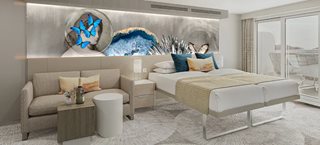
Category: M2
Accommodates 2-4, total approximate size 358 - 412 sq. ft, balcony size 129 - 185 sq. ft
With plenty of room for up to four guests, these Club Balcony Suites feature two lower beds that convert to a queen, some with a single or double sofa bed, spacious bathroom, and a sliding glass door that leads to a forward-facing balcony offering spectacular views. Due to potential high wind speeds at the front of the ship, this cabin features solid metal bulwarks (railings) and/or glass windscreens.
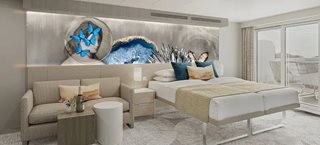
Category: SL
Accommodates 4, total approximate size 393 - 434 sq. ft, balcony size 129 sq. ft
An ideal retreat for the whole family, these Suites feature two lower beds that convert to a queen, a double sofa bed, plus a forward-facing balcony offering stunning views. Round out your picture-perfect family vacation with the indulgence of butler and concierge service.
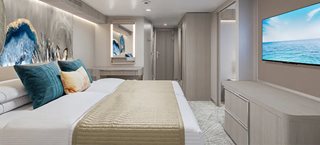
Category: SK
Accommodates 4, total approximate size 412 - 487 sq. ft, balcony size 153 - 191 sq. ft
Stunning views are straight ahead from the large, private balcony of these forward-facing, luxury Suites, perfect for up to four guests. Includes a separate bedroom with two lower beds that convert to a queen, a double sofa bed, spacious bath, and butler and concierge service for the ultimate getaway. Due to potential high wind speeds at the front of the ship, this cabin features solid metal bulwarks (railings) and/or glass windscreens.
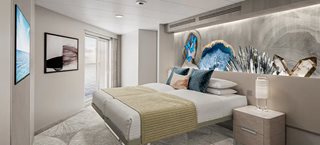
Category: SJ
Accommodates 4, total approximate size 388 sq. ft, balcony size 45 sq. ft
Perfect for the whole family, these Suites are located mid-ship and have plenty of room to spread out. They feature a separate bedroom with two lower beds that convert to a queen, a double sofa bed and spacious bath. Includes butler and concierge service, too.
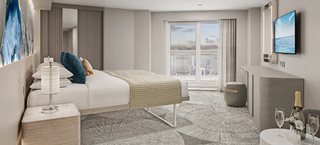
Category: SI
Accommodates 2, total approximate size 448 sq. ft, balcony size 195 sq. ft
There is plenty of room for you to relax and take in the gorgeous views from the aft-facing balcony of these stylish Suites. Featuring two lower beds that convert to a queen, they can connect to a Club Balcony Suite, perfect for family or friends to spread out yet stay close. Includes butler and concierge, too.
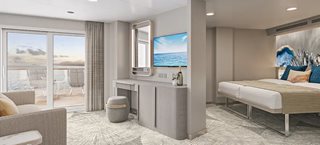
Category: SH
Accommodates 4, total approximate size 635 sq. ft, balcony size 370 sq. ft
Marvel at the unparalleled views from the large, aft-facing balcony of these spacious, stylish Suites featuring two lower beds that convert to a queen and a double sofa bed. They also include butler and concierge service. Perfect for up to four guests to indulge in a picture-perfect vacation.

Category: HE
Accommodates 2-3, total approximate size 368 - 418 sq. ft, balcony size 84 - 134 sq. ft
These luxury Penthouses have access to The Haven amenities and feature a king-size bed, some with bedding to accommodate one more, luxury bath with jetted shower plus a sitting area and a large balcony to admire the gorgeous views. Includes butler and concierge service for the ultimate luxury vacation.
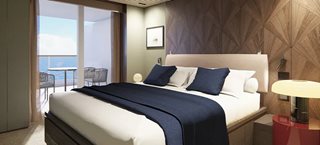
Category: HB
Accommodates 2-4, total approximate size 496 - 599 sq. ft, balcony size 129 - 220 sq. ft
Located in the exclusive enclave of The Haven, retreat to your luxury Penthouse that features a master bedroom with king-size bed and an aft-facing balcony offering awe-inspiring views. Some cabins contain a double sofa bed. Also includes the indulgence of butler and concierge service. (ADA stateroom does not have a separate bedroom.)
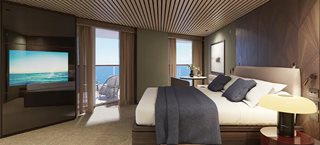
Category: HA
Accommodates 2, total approximate size 830 sq. ft, balcony size 498 sq. ft
Enjoy sophisticated style and luxury in this aft-facing, spacious Penthouse with a large balcony offering incredible views from the back of the ship and an outdoor hot tub. Features include a king-size bed, luxury bath with jetted shower and access to exclusive amenities for guests of The Haven. Butler and concierge service provide the finishing touch.
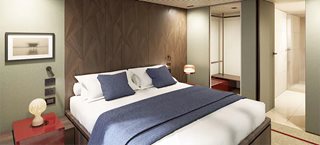
Category: H6
Accommodates 6, total approximate size 606 - 658 sq. ft, balcony size 138 - 190 sq. ft
These Villas located in The Haven provide the ideal luxury retreat for the whole family. They feature two bedrooms, one king-size bed, one queen-size bed, a double sofa bed, two bathrooms with jetted showers, and a large balcony to gather together and enjoy the beautiful views or snuggle under the stars. Plus, access to The Haven amenities and butler and concierge service to complete your picture-perfect vacation.
Note: Cabins 13900, 14300, 14900, 15300, and 15900 have a partially obstructed view.
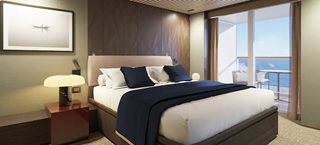
Category: H5
Accommodates 4, total approximate size 541 - 614 sq. ft, balcony size 109 - 132 sq. ft
Retreat to your sumptuous private oasis in The Haven Owner's Suite, featuring a separate bedroom in most with king-size bed, a double sofa bed to accommodate two more, living area, luxury shower and a large balcony to gather together and enjoy the beautiful vistas. Butler and concierge service round out your incredible getaway.
Please note: Staterooms 12322 and 12926 do not have a separate bedroom or bathtub.
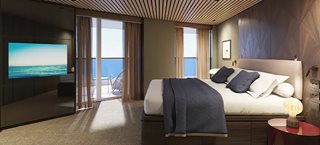
Category: H4
Accommodates 4, total approximate size 974 - 994 sq. ft, balcony size 527 - 535 sq. ft
Located in the exclusive enclave of The Haven, these luxury Owner's Suites feature a stylish master bedroom with king-size bed, a double sofa bed to accommodate two more, luxury bath with jetted shower and incredible views from the large, aft-facing balcony, some with an outdoor hot tub. Plus, a concierge and 24-hour butler to tend to your every wish. * Suites on deck 10 (10352 and 10952) do not include the outdoor hot tub.

Category: H3
Accommodates 6, total approximate size 1,607 - 1,749 sq. ft, balcony size 613 - 732 sq. ft
Marvel at the magnificent views from the aft-facing balcony of your luxury Deluxe Owner's Suite located in The Haven. Featuring a separate living and dining area, they also include two bedrooms with king-size beds, two luxury baths with jetted showers, a half-bath, additional bedding to accommodate six total guests and an outdoor hot tub. Butler and concierge service complete your vacation of indulgence.

Category: H2
Accommodates 8, total approximate size 2,100 sq. ft, balcony size 828 sq. ft
Located in The Haven, these stunning Suites offer breathtaking views from the large, aft-facing balcony. They feature spacious and luxurious accommodations that include separate living and dining areas, three bedrooms with king-size beds, a double sofa bed, three bathrooms with jetted showers, a half-bath, an outdoor hot tub and the indulgence of butler and concierge service to tend to your every want.
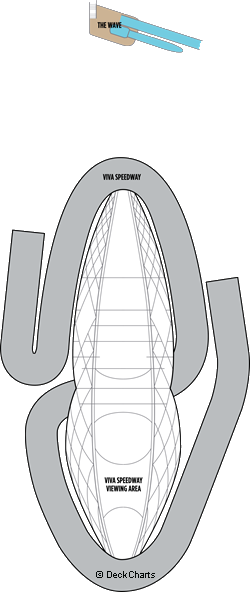
| Symbol | Description |
|---|---|
 | Stateroom with facilities for the disabled |
 | Connecting staterooms |
 | Third-person occupancy available |
 | Third- and/or fourth-person occupancy available |
 | Third-, fourth- and/or fifth-person occupancy available |
 | Up-to-sixth-person occupancy available |
 | Elevator |
 | Restroom |
 | Inside stateroom doors open to center interior corridors |
 | To be announced |

- Ship Name: Norwegian Viva
- Year Built: 2023
- Year Entered Present Fleet: 2023
- Ship Class: Prima Class
- Maximum Capacity: 4,012
- Number of Passenger Decks: 20
- Number of Crew: 1,388
- Ocean-View without Balcony: 124
- Total Inside Staterooms: 383
- Tonnage (GRT): 142,500
- Capacity Based on Double Occupancy: 3,215
- Country of Registry: The Bahamas
- Total Staterooms: 1,644
- Suites with Balcony: 1,137
- Crew/Hotel Staff Nationality: International
Costco Member Reviews

Available Dates & Prices
Terms & Conditions
*Price shown is per person based on double occupancy and is valid for select stateroom categories only. Click on the Terms & Conditions link below for details.
†One Digital Costco Shop Card per room/stateroom, per stay. The exact amount of the Digital Costco Shop Card will be calculated during the booking process. The Digital Costco Shop Card promotion is nontransferable and may not be combined with any other promotion. A Digital Costco Shop Card will arrive by email approximately 10 days after the start of your cruise. Click on the Terms & Conditions link below for additional information.
Ship's registry: The Bahamas
Images of the ship are an artist's rendering.
Digital Costco Shop Card
This booking includes a Digital Costco Shop Card which will arrive by email one to two weeks after you return from your vacation. The Digital Costco Shop Card is a convenient payment option in our warehouses and on Costco.ca.














